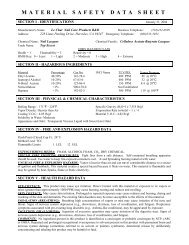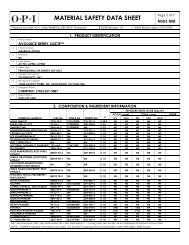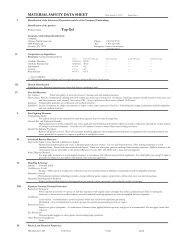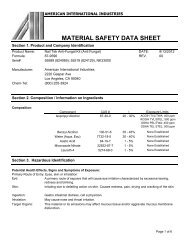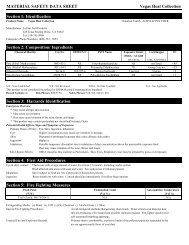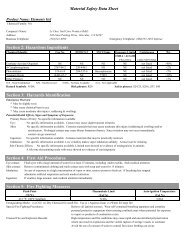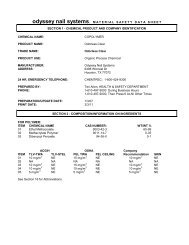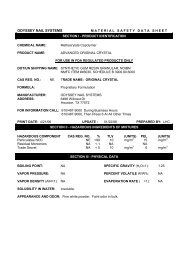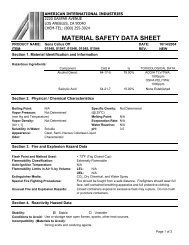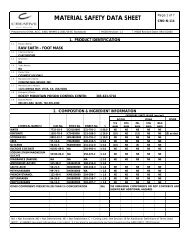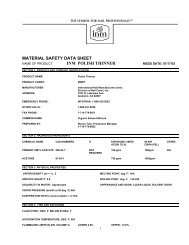MATERIAL SAFETY DATA SHEET - ProfessionalBeautyMails
MATERIAL SAFETY DATA SHEET - ProfessionalBeautyMails
MATERIAL SAFETY DATA SHEET - ProfessionalBeautyMails
Create successful ePaper yourself
Turn your PDF publications into a flip-book with our unique Google optimized e-Paper software.
<strong>MATERIAL</strong> <strong>SAFETY</strong> <strong>DATA</strong> <strong>SHEET</strong>Page 1 of 7MSDS-040Prepared to OSHA, ACC, ANSI, NOHSC, WHMIS & 2001/58 EC Standards MSDS Revision: 1.1 MSDS Revision Date: 01/01/20051. PRODUCT IDENTIFICATION1.1 Product Name:MICROBOND MICRO SCULPTURE CLEAR GLAZE GEL1.2 Chemical Name:METHACRYLATE MIXTURE1.3 Synonyms:NA1.4 Trade Names:MBM241.5 Product Use:PROFESSIONAL USE ONLY1.6 Manufacturer’s Name:OPI PRODUCTS, INC.1.7 Manufacturer’s Address:13034 SATICOY STREET, NO. HOLLYWOOD, CA 91605 USA1.8 Emergency Phone:CHEMTREC: +1 (703) 527-3887 / +1 (800) 424-93001.9 Business Phone:+1 (818) 759-2400 / +1 (800)-341-99992.1 Hazard Identification:2. HAZARD IDENTIFICATIONThis product is classified as a hazardous substance but not as dangerous goods according to the classification criteria of NOHSC andADG Code (Australia).2.2 Routes of Entry: Inhalation: YES Absorption: YES Ingestion: YES2.3 Effects of Exposure:INGESTION: If product is swallowed, may cause nausea, headache, vomiting and/or diarrhea and central nervous systemdepression.SKIN & EYES: Irritating to the eyes. Symptoms of overexposure may include redness, itching, irritation and watering. May beirritating to skin in some sensitive individuals, especially after prolonged and/or repeated contact.INHALATION: Inhalation of vapors is unlikely under normal conditions of use and handling; however, inhalation of vapors in excess ofthe levels listed in Section 2 (Composition and Ingredient Information) can cause central nervous system depression(e.g., drowsiness, dizziness, headaches, nausea).2.4 Symptoms of Overexposure:Symptoms of skin overexposure in some sensitive individuals may include redness, itching, and irritation of affected areas.Overexposure in eyes may cause redness, itching and watering.2.5 Acute Health Effects:Mild to moderate irritation to eyes and skin near affected areas.2.6 Chronic Health Effects:None known.2.7 Target Organs:Eyes, skin.NA = Not Available; ND = Not Determined; NE = Not Established; C = Ceiling Limit; See Section 16 for Additional Definitions of Terms UsedNOTE: all WHMIS required information is included. It is located in appropriate sections based on the ANSI Z400.1-2004 format.
<strong>MATERIAL</strong> <strong>SAFETY</strong> <strong>DATA</strong> <strong>SHEET</strong>Page 2 of 7MSDS-040Prepared to OSHA, ACC, ANSI, NOHSC, WHMIS & 2001/58 EC Standards MSDS Revision: 1.1 MSDS Revision Date: 01/01/20053. COMPOSITION & INGREDIENT INFORMATIONCHEMICAL NAME(S) CAS No. RTECS No. EINECS No. %URETHANE METHACRYLATEOLIGOMERSTRIETHYLENE GLYCOLDIMETHACRYLATEEXPOSURE LIMITS IN AIR (mg/m 3 )ACGIH - ppm OSHA - ppm OTHERTLV STEL PEL STEL IDLHNA NA NA ≤ 90.0 NE NE NE NE NE109-16-0 OZ4100000 203-652-6 ≤ 10.0 NE NE NE NE NESILICA 112945-52-5 VV7310000 215-683-2 ≤ 5.0 (6) NE (6) NE NE as a dustHYDROXYMETHYLPHENYLPROPANONE4.1 First Aid:7473-98-5 NA 231-272-0 ≤ 1.0 NE NE NE NE NE4. FIRST AID MEASURESINGESTION: If ingested, do not induce vomiting. If product has been swallowed, drink plenty of water or milk IMMEDIATELY. If thepatient is vomiting, continue to offer water or milk. Never give water or milk to an unconscious person. Contact thenearest Poison Control Center or local emergency number. Provide an estimate of the time at which the material wasingested and the amount of the substance that was swallowed.EYES: Splashes are not likely; however, if product gets in the eyes, flush with copious amounts of lukewarm water for at least15 minutes. If irritation occurs, contact a physician.SKIN: If irritation occurs and product is on the skin, rinse thoroughly with lukewarm water, followed by a thorough washing ofthe effected area with soap and water. If irritation, redness or swelling persists, contact a physician immediately.INHALATION: Remove victim to fresh air.4.2 Medical Conditions Aggravated by Exposure:None known.5.1 Flashpoint & Method:> 82°C (180°F) c.c.5.2 Autoignition Temperature:NA5. FIREFIGHTING MEASURESHEALTH 1FLAMMABILITY 1REACTIVITY 1PROTECTIVE EQUIPMENT B5.3 Flammability Limits: Lower Explosive Limit (LEL): ND Upper Explosive Limit (UEL): ND5.4 Fire & Explosion Hazards:Exothermic polymerization may cause containers to rupture. Cool containers with water to preventpolymerization.5.5 Extinguishing Methods:CO2, Halon, Dry Chemical, Foam5.6 Firefighting Procedures:This product is a combustible liquid. When involved in a fire, this product may ignite readily and decomposeto produce carbon oxides.First responders should wear eye protection. Structural firefighters must wear SCBAs and full protectiveequipment. Use a water spray or fog to reduce or direct vapors. Water may not be effective in actuallyextinguishing a fire involving this product.EYESSKIN
<strong>MATERIAL</strong> <strong>SAFETY</strong> <strong>DATA</strong> <strong>SHEET</strong>Page 3 of 7MSDS-040Prepared to OSHA, ACC, ANSI, NOHSC, WHMIS & 2001/58 EC Standards MSDS Revision: 1.1 MSDS Revision Date: 01/01/20056.1 Spills:6. ACCIDENTAL RELEASE MEASURESBefore cleaning any spill or leak, individuals involved in spill cleanup must wear appropriate Personal Protective Equipment.For small spills (e.g.,
<strong>MATERIAL</strong> <strong>SAFETY</strong> <strong>DATA</strong> <strong>SHEET</strong>Page 4 of 7MSDS-040Prepared to OSHA, ACC, ANSI, NOHSC, WHMIS & 2001/58 EC Standards MSDS Revision: 1.1 MSDS Revision Date: 01/01/20059.1 Density: ND9.2 Boiling Point: > 212 °F9.3 Melting Point: NE9.4 Evaporation Rate: NE9.5 Vapor Pressure: NE9.6 Molecular Weight: NE9.7 Appearance & Color: Clear viscous gel.9.8 Odor Threshold: Characteristic acrylate odor.9.9 Solubility: Immiscible.9.10 pH ND9.11 Viscosity: 85000 – 90000 cPs9.12 Other Information: ND9. PHYSICAL & CHEMICAL PROPERTIES10. STABILITY & REACTIVITY10.1 Stability:Stable under ambient conditions when stored properly (see Section 7, Storage and Handling).10.2 Hazardous Decomposition Products:If exposed to extremely high temperatures, the products of thermal decomposition may include irritating vapors and carbon oxidegases (e.g., CO, CO2).10.3 Hazardous Polymerization:May occur, if exposed to extremely high temperatures.10.4 Conditions to Avoid:None known.10.5 Incompatible Substances:This product is incompatible with alkaline metals, strong oxidizers (e.g., peroxides, superoxides), strong acids (e.g., hydrochloric ormuriatic acids), or strong bases (e.g., lye, potassium hydroxide).11. TOXICOLOGICAL INFORMATION11.1 Toxicity Data:This product has NOT been tested on animals to obtain toxicology data. There are toxicology data for the components of theproduct, which are found in scientific literature. These data have not been presented in this document.11.2 Acute Toxicity:See Section 2.511.3 Chronic Toxicity:See Section 2.611.4 Suspected Carcinogen:No11.5 Reproductive Toxicity:This product is not reported to cause reproductive toxicity in humans.Mutagenicity:This product is not reported to produce mutagenic effects in humans.Embryotoxicity:This product is not reported to produce embryotoxic effects in humans.Teratogenicity:This product is not reported to cause teratogenic effects in humans.Reproductive Toxicity:This product is not reported to cause reproductive effects in humans.11.6 Irritancy of Product:See Section 2.311.7 Biological Exposure Indices:NE11.8 Physician Recommendations:Treat symptomatically.
<strong>MATERIAL</strong> <strong>SAFETY</strong> <strong>DATA</strong> <strong>SHEET</strong>Page 5 of 7MSDS-040Prepared to OSHA, ACC, ANSI, NOHSC, WHMIS & 2001/58 EC Standards MSDS Revision: 1.1 MSDS Revision Date: 01/01/200512.1 Environmental Stability:There are no specific data available for this product.12.2 Effects on Plants & Animals:There are no specific data available for this product.12. ECOLOGICAL INFORMATION12.3 Effects on Aquatic Life:There are no specific data available for this product; however, very large releases of this product may be harmful or fatal tooverexposed aquatic life.13. DISPOSAL CONSIDERATIONS13.1 Waste Disposal:Waste disposal must be in accordance with appropriate federal, state, and local regulations.13.2 Special Considerations:NA14. TRANSPORTATION INFORMATIONThe basic description (proper shipping name, hazard class & division, ID Number, packing group) is shown for each mode of transportation.Additional descriptive information may be required by 49 CFR, IATA/ICAO, IMDG and the CTDGR.14.1 49 CFR (GND):NOT REGULATED14.2 IATA (AIR):NOT REGULATED14.3 IMDG (OCN):NOT REGULATED14.4 TDGR (Canadian GND):NOT REGULATED14.5 ADR/RID (EU):NOT REGULATED14.6 MEXICO (SCT):NOT REGULATED15. REGULATORY INFORMATION15.1 SARA Reporting Requirements:NA15.2 SARA Threshold Planning Quantity:There are no specific Threshold Planning Quantities for the components of this product.15.3 TSCA Inventory Status:The components of this product are listed on the TSCA Inventory as appropriate.15.4 CERCLA Reportable Quantity (RQ):NA15.5 Other Federal Requirements:This product complies with the appropriate sections of the Food and Drug Administration's 21 CFR subchapter G (Cosmetics).15.6 Other Canadian Regulations:This product has been classified according to the hazard criteria of the CPR and the MSDS contains all ofthe information required by the CPR. The components of this product are listed on the DSL/NDSL. Noneof the components of this product are listed on the Priorities Substances List.15.7 State Regulatory Information:None of the ingredients in this mixture are listed in any state criteria lists.15.8 67/548/EEC (European Union) Requirements:The primary component of this product is not listed in Annex I of EU Directive 67/548/EEC.S: 2 - Keep out of reach of children. Do not take internally. Discontinue use if sensitization occurs. Ifaccidental eye contact occurs, flush with water for at least 15 minutes and get prompt medicalattention.
<strong>MATERIAL</strong> <strong>SAFETY</strong> <strong>DATA</strong> <strong>SHEET</strong>Page 6 of 7MSDS-040Prepared to OSHA, ACC, ANSI, NOHSC, WHMIS & 2001/58 EC Standards MSDS Revision: 1.1 MSDS Revision Date: 01/01/200516.1 Other Information:16. OTHER INFORMATIONKeep out of reach of children. Do not take internally. Keep away from heat and open flame.16.2 Terms & Definitions:See last page of this MSDS.16.3 Disclaimer:This Material Safety Data Sheet is offered pursuant to OSHA’s Hazard Communication Standard, 29 CFR §1910.1200. Othergovernment regulations must be reviewed for applicability to this product. To the best of ShipMate's & OPI Products’ knowledge, theinformation contained herein is reliable and accurate as of this date; however, accuracy, suitability or completeness are notguaranteed and no warranties of any type, either expressed or implied, are provided. The information contained herein relates onlyto the specific product(s). If this product(s) is combined with other materials, all component properties must be considered. Datamay be changed from time to time. Be sure to consult the latest edition.16.4 Prepared for:OPI Products, Inc.13034 Saticoy StreetNo. Hollywood, CA 91605 USA+1 (818) 759-2400 phone+1 (818) 759-5770 faxhttp://www.opi.com/16.5 Prepared by:ShipMate, Inc.18436 Hawthorne Boulevard, Suite 201Torrance, CA 90504 USA+1 (310) 360-3700 phone+1 (310) 360-5700 faxhttp://www.shipmate.com/
<strong>MATERIAL</strong> <strong>SAFETY</strong> <strong>DATA</strong> <strong>SHEET</strong>Page 7 of 7MSDS-040Prepared to OSHA, ACC, ANSI, NOHSC, WHMIS & 2001/58 EC Standards MSDS Revision: 1.1 MSDS Revision Date: 01/01/2005DEFINITION OF TERMSA large number of abbreviations and acronyms appear on a MSDS. Some of these that are commonly used include the following:GENERAL INFORMATION:NATIONAL FIRE PROTECTION ASSOCIATION: NFPACAS No.Chemical Abstract Service NumberFLAMMABILITY LIMITS IN AIR:EXPOSURE LIMITS IN AIR:ACGIH American Conference on Governmental Industrial HygienistsTLV Threshold Limit ValueOSHA U.S. Occupational Safety and Health AdministrationPEL Permissible Exposure LimitIDLH Immediately Dangerous to Life and HealthFIRST AID MEASURES:AutoignitionTemperatureLELUELMinimum temperature required to initiate combustionin air with no other source of ignitionLower Explosive Limit - lowest percent of vapor in air, byvolume, that will explode or ignite in the presence ofan ignition sourceUpper Explosive Limit - highest percent of vapor in air,by volume, that will explode or ignite in the presence ofan ignition sourceCPRCardiopulmonary resuscitation - method in which a personwhose heart has stopped receives manual chestcompressions and breathing to circulate blood and provideoxygen to the body.HAZARDOUS <strong>MATERIAL</strong>S IDENTIFICATIONSYSTEM: HMISHEALTH, FLAMMABILITY & REACTIVITY RATINGS:0 Minimal Hazard1 Slight Hazard2 Moderate Hazard3 Severe Hazard4 Extreme HazardPERSONAL PROTECTION RATINGS:ABCDEFSafety GlassesSplash GogglesGHIJKXConsult your supervisor or S.O.P. forspecial handling directions.Face Shield &Eye ProtectionGlovesBoots Synthetic Apron Full Suit Dust RespiratorVapor RespiratorDust & VaporRespiratorOTHER STANDARD ABBREVIATIONS:NANRNENDMLSCBAFull FaceRespiratorAirline Hood/Maskor SCBANote: the dotted circle indicates that this respiratory protectiveequipment is required for high concentrations or for largevolume spills or releases of product.Not AvailableNo ResultsNot EstablishedNot DeterminedMaximum LimitSelf-Contained Breathing ApparatusHMIS®HEALTHFLAMMABILITYREACTIVITYPERSONAL PROTECTIONNCCHL44T ©NPCA Printed by Labelmaster, A, American Labelmark Co., Chicago, IL 60646 (800) 621-5808HAZARD RATINGS:0 Minimal Hazard1 Slight Hazard2 Moderate Hazard3 Severe Hazard4 Extreme HazardACD AcidicALK AlkalineCOR CorrosiveW Use No WaterOX OxidizerTOXICOLOGICAL INFORMATION:LD50LC50ppmTDloTCLoTDlo, LDlo, & LDo orTC, TCo, LClo, & LCoIARCNTPRTECSBCFTLmlog KOW or log KOCREGULATORY INFORMATION:WHMISDOTTCEPADSLNDSLPSLTSCAEUEC INFORMATION:FLAMMABILITYHEALTHREACTIVITYSPECIALPRECAUTIONSLethal Dose (solids & liquids) which kills 50% of theexposed animals sLethal concentration (gases) which kills 50% of theexposed animalConcentration expressed in parts of material permillion partsLowest dose to cause a symptomLowest concentration to cause a symptomLowest dose (or concentration) to cause lethal ortoxic effectsInternational Agency for Research on CancerNational Toxicology ProgramRegistry of Toxic Effects of Chemical SubstancesBioconcentration FactorMedian threshold limitCoefficient of Oil/Water DistributionCanadian Workplace Hazardous Material Information SystemU.S. Department of TransportationTransport CanadaU.S. Environmental Protection AgencyCanadian Domestic Substance ListCanadian Non-Domestic Substance ListCanadian Priority Substances ListU.S. Toxic Substance Control ActEuropean Union (European Union Directive 67/548/EEC)C E F N O T+ Xi XnCorrosive Explosive Flammable Harmful Oxidizing Toxic Irritant Harmful



